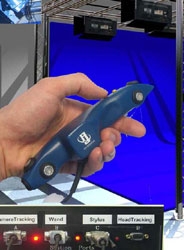 |
Michael Cohen: Presentation at the Duesseldorf University of Applied Sciences
Michael Cohen
Spatial Media Group
Human Interface Lab.
University of Aizu 965-8580
Japan
email: mcohen@u-aizu.ac.jp
WWW: http://www.u-aizu.ac.jp/~mcohen
Michael Cohen was born in Hartford, Connecticut, USA on 31 March 1959.
He received an Sc.B. in EE from Brown University (Providence, Rhode Island)
in 1980, M.S. in CS from the University of Washington (Seattle) in 1988,
and Ph.D. in EECS from Northwestern University (Evanston, Illinois) in
1991. He has worked at the Air Force Geophysics Lab (Hanscom Field,
Massachusetts), Weizmann Institute (Rehovot; Israel), Teradyne (Boston,
Massachusetts), BBN (Cambridge, Massachusetts and Stuttgart; Germany),
Bellcore (Morristown and Red Bank, New Jersey), the Human Interface
Technology Lab (Seattle, Washington), and the Audio Media Research Group
at the NTT Human Interface Lab (Musashino and Yokosuka; Japan). He is
currently an Associate Professor in the Human Interface Lab at the
University of Aizu (Aizu-Wakamatsu, Japan).
He has research interests in
user interfaces for telecommunications,
groupware and CSCW (computer-supported collaborative work),
stereotelephonics, digital typography and electronic publishing,
hypermedia, ubicomp (ubiquitous computing) and virtual reality.
Besides teaching various undergraduate courses including Information Theory,
he co-teaches graduate-level courses in Acoustic Modeling,
and Computer Music.
He is a member of the ACM, IEEE, 3D-Forum, TUG (TeX Users Group), and VRSJ (Virtual Reality Society of Japan).
Cohen is the author or coauthor of two patents, three book chapters, and over forty papers.
Personal Communication into the 21st Century
Current foci of spatial audio research in recent literature comprise sound
localization; lateralization and binaural masking; echoes, precedence,
and depth perception; motion perception; sound source segregation and
free-field masking; physiology of spatial hearing; models of spatial
hearing; (childhood) development of spatial hearing; and applications of
binaural technology to auditory displays for human-computer interaction.
To cut across these categories in an attempt to outline the current
state-of-the-art in spatial auditory displays for a particular range of
applications, with an emphasis upon the expected performance of the
technology in producing specific user responses required for those
applications, this seminar considers the value of spatial audio technology
in the creation and presentation of virtual environments. The shared
synthetic worlds that networked computer users occupy constitute an
alternative reality that has come to be termed `cyberspace.' Auditory
display technology that attempts to provide such users with satisfying
experiences of virtual acoustical space is termed here "cyberspatial
audio" technology.
| Proxemic Context |
Architecture |
Audio |
Visual |
| intimate personal |
headset,wearable computers chair |
eartop (ex: headphones) nearphones |
eyetop (ex: HMDs) laptop display, desktop monitor |
| inter-personal |
couch or bench |
transaural speakers SDP (stereo dipole) |
HDTV |
| multi-personal |
automobiles |
surround sound (ex: Ambisonics) |
projection spatially immersive displays (ex: Cave, Cabin) |
| social |
clubs, theaters |
speaker array (ex: VBAP [vector-based amplitude panning]) |
large-screen displays (ex: IMAX) |
| public |
stadia, concert arenas |
public address |
(ex: Jumbotron) |
Audio and visual displays along a private <---> public continuum
Precursors to modern spatial audio systems, many of which are still
sold with labels like "3D sound" or "multidimensional sound," include
spatial enhancers and stereo spreaders. Spatial enhancers filter mono
or stereo inputs to add a sense of depth and spaciousness to the
signal, allowing for simple operation and backwards compatibility, but
precluding placement of individual sounds. Stereo spreaders filter
mono inputs, placing the sound along a linear range to extend the
sound field. While such approaches allow for realtime user
adjustments, the techniques do not include distance or elevation
models.
The most direct approach to spatializing audio is to simply position
sound sources relative to the listeners, as in antiphonal concerts.
Directly spatialized audio--- including attractions like Wisconsin's
House on the Rock (www.thehouseontherock.com), a museum which features
entire rooms lined with orchestral automata--- has charm, but is not
practical for anything but special-purpose venues and LBE
(Location-Based Entertainment). Fully articulated spatial audio
allows dynamic (runtime), arbitrary placement and movement of
multiple, separate, sources in a soundscape as well as extra
dimensions encoding sound image size, orientation, and environmental
characteristics.
Delivery mechanisms for virtual spatial audio can be organized along a
continuum of scale. At one end of the spectrum, simple
amplitude-panning (balance), perhaps best deployed as constant power
cross-fader, can be thought of as a "poor person's spatializer." In
conjunction with exocentric visual cues (like a map of sources and
sinks, even such a degenerately simple technique, capable of only
lateral (left<->right) effects, can be effective for some
applications. In conjunction with egocentric visual cues (like
first-person perspective shifts in a large part of the visual field),
lateral shifts in the auditory image can disambiguate frontward from
rearward sound source incidence angles. Therefore, this simple
manipulation can carry surprisingly useful information in applications
allowing locomotion through a virtual environment (such as computer
games that require tracking other players while exploring a
3D-model-based world).
|
 |
